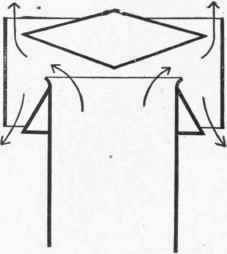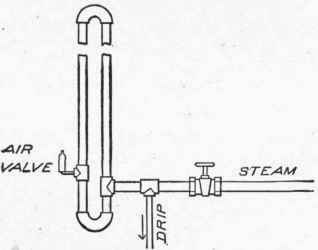Vent Flues
Description
This section is from the book "Cyclopedia Of Architecture, Carpentry, And Building", by James C. et al. Also available from Amazon: Cyclopedia Of Architecture, Carpentry And Building.
Vent Flues
In dwelling houses vent flues are often omitted and the frequent opening of doors and leakage are depended upon to carry away the impure air. A well designed system of warming should provide some means for discharge ventilation, especially for bath and toilet rooms, and also for living rooms where lights are burned in the evening. The sizes of flues may be made the reverse of the warm-air flues, that is, 1 1/2 square inches area per square foot of indirect radiation for rooms on the first floor and 2 square inches for those on the second. This is because the velocity of flow will depend upon the height of flue and will therefore be greater from the first floor. The flues should be joined together in the attic and then carried through the roof where a ventilating hood should be provided, especially designed to keep out the rain and snow. A good form is shown in Fig. 14.
Very good results may be obtained by simply letting the flues open into an unfinished attic and depending upon leakage through the roof to carry away the foul air. The flow of air through the vents will be slow at best unless some means is provided for warming the air in the flue to a temperature above that of the room with which it connects. This may be done by carrying up a loop of steam pipe inside of the flue. It should be connected for drainage and air venting as shown in Fig. 15.

Fig. 13.
For schoolhouse work we may assume average velocities through the vent flues as follows:
1st floor 340 feet per min. 2nd " 280 " " " 3rd " 220 " " " Where flue sizes are based on these velocities it is well to guard against down drafts by placing an aspirating coil in the flue. A single row of pipes across the flue as shown in Fig. 16 is usually sufficient for this purpose. The slant height of the heater should be about twice the depth of the flue so that the area between the pipes shall equal the free area of the flue.
Large vent flues of this kind should always be provided with dampers for closing at night and for regulation during strong winds. Sometimes it is desired to move a given quantity of air through a flue which is already in place.
Table I shows what velocities may be obtained through flues of different heights for varying differences in temperature between the outside air and that in the flue.
Example. - It is desired to discharge 1300 cubic feet of air per minute through a flue having an area of 4 square feet and a height of 30 feet. If the efficiency of an aspirating coil is 400 B. T. U. how many square feet of surface will be required to move this amount of air when the temperature of the room is 70° and the outside temperature is 60°?
1300/ 4 = 325 feet per minute = velocity through the flue. Looking in table I and following along the line opposite a 30-foot flue we find that to obtain this velocity there must be a difference of 30 degrees between the air in the flue and the external air. If the outside temperature is 60 degrees then the air in the flue must be raised to 60 4- 30 = 90 degrees. The air

Fig. 14.
TABLE I. | ||||||
Height of Flue in Feet. | Excess of Temperature of Air in Flue above that of External Air. | |||||
5° | 10° | 15° | 20° | 30° | 50° | |
5 | 55 | 76 | 94 | 109 | 134 | 167 |
10 | 77 | 108 | 133 | 153 | 188 | 242 |
15 | 94 | 133 | 162 | 188 | 230 | 297 |
20 | 108 | 153 | 188 | 217 | 265 | 342 |
25 | 121 | 171 | 210 | 242 | 297 | 383 |
30 | 133 | 188 | 230 | 265 | 325 | 419 |
35 | 143 | 203 | 248 | 286 | 351 | 453 |
40 | 153 | 217 | 265 | 306 | 375 | 484 |
45 | 162 | 230 | 282 | 325 | 398 | 514 |
50 | 171 | 242 | 297 | 342 | 419 | 541 |
60 | 188 | 264 | 325 | 373 | 461 | 594 |
of the room being at 70 degrees, a rise of 20 degrees is necessary, so the problem resolves itself into the following - What amount of heating surface, having an efficiency of 400 B. T. U. is necessary to raise 1300 cubic feet of air per minute through 20 degrees? 1300 cubic feet per minute = 1300 X 60 = 78,000 per hour, and making use of our formula for "heat for ventilation," we have

Fig. 15.
78,000 X 20 = 28,363 B. T. U. 55 and this divided by 400 = 71 square feet of heating surface required.

Fig. 16.
Example. - What size of heater will be required in a vent flue 40 feet high and with an area of 5 square feet, to enable it to discharge 1530 cubic feet per minute, when the outside temperature is 60° ? (Assume a heater efficiency of 400 B. T. U.)
Velocity in flue = 1530/ 5 = 306 feet per minute.
Temperature excess, from Table I, = 20 degrees.
B. T. U. required per hour = 1530 X 60 X 10/ 55 = 16690 requiring 16690/ 400 = 41.7 square feet of heater.
Continue to:


